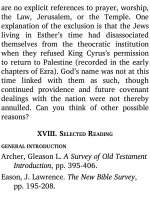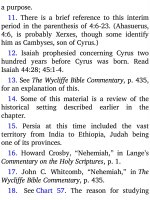Jensens survey of the old testament adam 72
Bạn đang xem bản rút gọn của tài liệu. Xem và tải ngay bản đầy đủ của tài liệu tại đây (168.68 KB, 4 trang )
can expect to hear the trumpet as the signal
to cross over the Jordan into the land. They
have to drive out the enemy, but success is
assured, for their God has said, “I will give it
[the land] to you” (10:29).
The ve books of Moses (Pentateuch), as
noted earlier, constitute a whole. Numbers,
as the fourth part of that whole, makes its
indispensable contribution. This may be seen
in the following comparisons:
I. PREPARATION
FOR
STUDY
1. Acquaint yourself with the geography
of the Numbers narrative. See Map F,
studied earlier. It is very helpful to visualize
location as you study action in any historical
account. As indicated earlier, the story of
Numbers moves from Mount Sinai to the
plains of Moab, opposite Jericho.
2. Review the accounts of Exodus and
Leviticus, which are the antecedents of the
book of Numbers.
3. Be prepared to read about many
supernatural worka of God in behalf of the
Israelites. These are a continuation of His
mighty deeds recorded in Exodus. Do you
know why God performed so many miracles
in Old Testament times?
4. Be thinking of what the extent of the
average Jew’s acquaintance was with God at
the beginning of the journey of Numbers.
II. BACKGROUND
A. TITLE
This fourth book of Moses has had various
titles (e.g., “Book of Journeyings,” “Book of
Murmurings”). According to the Hebrew
custom of deriving its title from the rst
word of the Hebrew text, it has been called
Wayyedabber, meaning simply, “And he
said.” When the Septuagint translators
a xed a title to the book, they chose the
Greek word Arithmoi, meaning “Numbers,”
the word being suggested by the two
numberings, or censuses, of the people as
recorded in the book (Num 1 and 26). The
Latin Vulgate named it Liber Numeri (“Book
of Numbers”), which was carried over into
the English versions. It must be true that not
a few readers and students of the Bible have
passed by the fourth book of Moses because
of the “dry” connotation of this title. But it
is both an exciting and inspiring story, and
all who spend time studying it receive much
benefit.
B. AUTHOR
External and internal evidences point
conclusively to Mosaic authorship of all ve
books of the Pentateuch, which includes
Numbers. Moses certainly was a logical
choice of God to write Numbers, since he
was the chief eyewitness of its events.
C. DATE
Moses wrote Numbers when he was at
Moab with his people, toward the end of his
life at the close of the fifteenth century B.C.
III. SURVEY
1. Begin your survey study by scanning
the thirty-six chapters of Numbers. Record
on paper chapter titles similar to the ones
shown on Chart 24.
2. Note on Chart 24 where the two main
censuses are recorded in the book. The
second
census
involves
a
di erent
generation from the rst. To understand the









